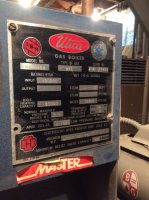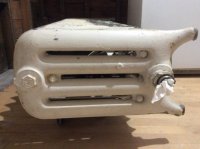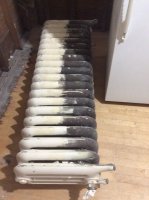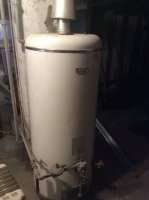I'm not sure what the "...100' sf..." dimension is intended to mean. Are you talking about "
equivalent direct radiation" square feet of all the radiators?
Replacing like for like is usually a mistake. Typical oversizing of 3x or more has efficiency, comfort, and maintenance/longevity consequences. If you can't size the boiler to the design heat load, at least size it to where it won't short-cycle on the existing radiation. Errors on both are common, especially when (as is likely) the boiler has been replaced at least twice since the house was first built. The original house was probably a lot leakier, with less insulation, single pane windows/no-storms, and the original boiler was typical at least 2x oversized for the actual design load of the house in the pre-tightened pre-insulated condition, and 3x or more oversized for it's current condition.
With any replacement boiler it's important to know the square feet EDR of radiator you'll be hooking up to. Take a look at the document in the above link, then measure up your radiation to estimate the EDR'. If you can come up with the EDR' it's possible to put an upper bound on the size of the boiler. If your current 83K-output boiler is tied to radiation than only emit 40K into the room doesn't heat the place any better or faster than a 40K-output boiler. The EDR' also tells you how small a cast iron boiler can be without running into potentially destructive too-cool condensing return-water temperature problems.
The DOE output of the boiler nameplate in the picture is enough to heat a ~2500' of floor area in 2x4 /R13 bungalow about twice over, maybe 3x if it's an efficient shape (= basically a square or rectangular footprint, not a lot of corners, without a gazillion tiny dormers up top). With enough square feet EDR of radiator you may be able to heat the whole thing at domestic hot water temps with a condensing gas water heater (for both heat & hot water.)
Assuming you have a heating history on the place, start by running a
fuel use heat load calculation on last winter's gas billing, using the existing boiler with it's 83% nameplate efficiency as the measuring instrument.
Replacing the existing 83K BTU-output boiler with an 80-100K-in modulating condensing boiler and an indirect fired tank would certainly work.
HTP's UFT-080W and UFT-100W fire-tube modulating condensing boilers can almost always work as a drop-in replacement for a 100 KBTU-in cast iron system without substantially changing the system design. Unlike most other mod-con boiler vendors they advertise these as being able to pump direct just like a cast-iron beastie, no need for primary/secondary plumbing sculptures, and they have a purpose-made pre-plumbed secondary output to support an indirect water heater. They are also inexpensive, no more expensive to install (and usually less) than a power vented mid-efficiency cast iron boiler. The venting of the mod-con is plastic. Given that the old Utica is probably ridiculously oversized, and you're tightening up the place, the UFT-080W would be the better choice, even though it's DOE output is ~10KBTU/hr less than the old boiler.
But if you can't wrap your head around a cheap mod-con, a
Burnham ESC3 or ESC4 direct-vented boiler would drop right in, and can be side-vented. Just as with a mod-con the fact that it is direct-vented/sealed combustion it also means it won't depressurize the basement when running or provide an infiltration point- you can seal up the basement as tight as you like without concern or consequences. Even though the DOE output of the ESC3 is "only" 52,000 BTU/hr it's almost surely big enough for a reasonably house smaller than 3000 square feet, or even a fairly leaky 2000 square footer. With the lower output for the size of the radiation the return water to the boiler will be cooler, possibly cool enough to condense (TBD), but unlike most cast iron, the ESC boilers are self-protected internally to entering water temperatures as low as 110F, so dropping the size by 40% is not really much of a concern the way it might be with another vendor's line of cast iron boiler. If you have the EDR numbers the return water temps are fairly easy to predict.
So, measure up your radiators and check back. If you have a heating history sufficient for running the load calculation numbers I can help with that if it looks too complicated. Alternatively you can use an online Manual-J tool such as
loadcalc to come up with the whole house number, but the online load calculators usually take more time and is prone to oversizing error (which can be minimized by using the most aggressive assumptions about air tightness & R-values.)




